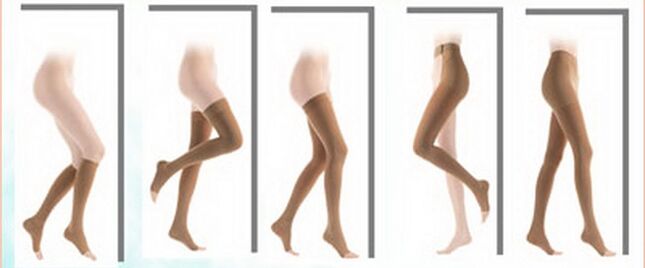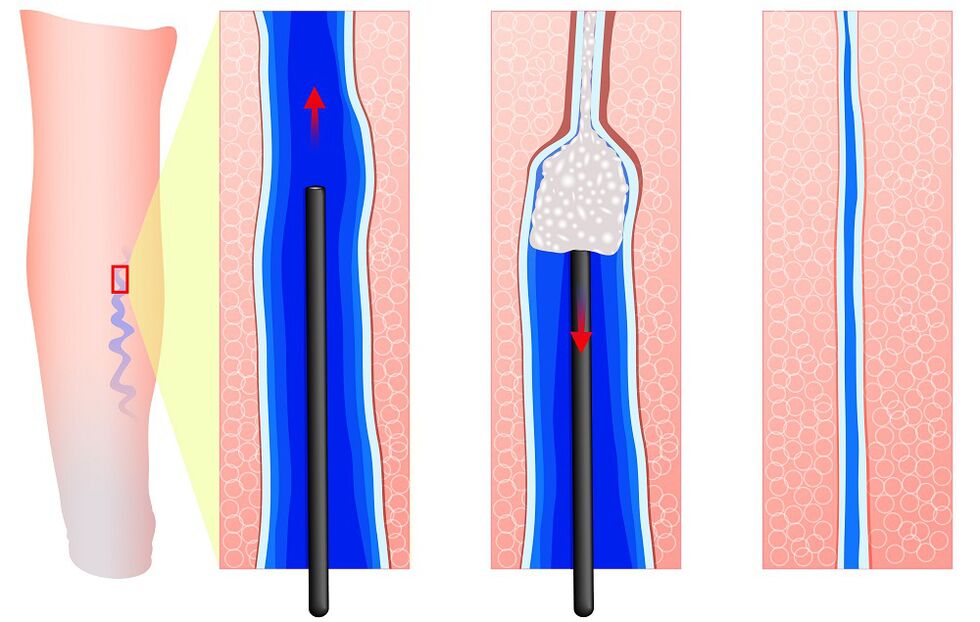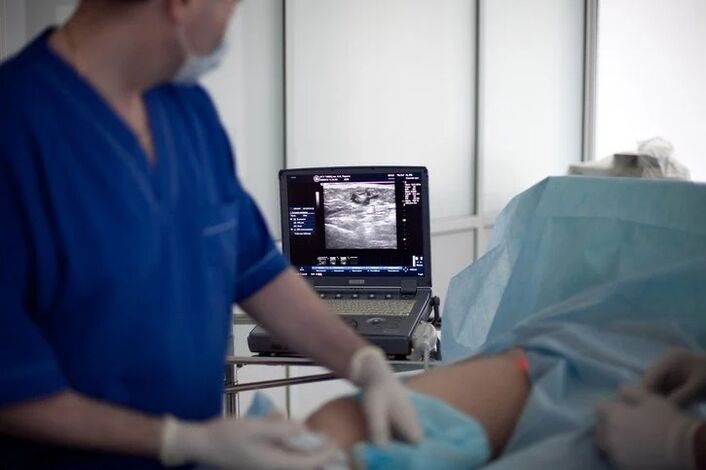
Varicose veins are a dangerous disease that carries with it many pathological processes. Treatment of varicose veins in the legs begins with lifestyle changes and medical procedures. They can: relieve the symptoms of varicose veins, prevent complications, improve the appearance of the lower legs.
Doctors may recommend switching to a diet and losing excess weight if varicose veins in the legs do not cause many symptoms. When there are serious signs of varicose veins in the legs, therapeutic and surgical treatment is prescribed.
Compression jersey
Compression stockings for varicose veins have a beneficial effect on the pressure on the veins.
Types of compression stockings for varicose veins:
- Support tights. Has the least pressure on the veins. They are securely attached to the legs and do not slip. Compression is evenly distributed.
- Knee socks. Can be worn by men and women. The compression is evenly distributed on the lower part of the body.
- Elastic bandage.The compression is unevenly distributed, so the pressure on the vein may be strong or weak. However, many people use this type of therapeutic knitwear because it is affordable.

Sclerotherapy
Vein sclerotherapy is the most common treatment for spider veins and varicose veins. The doctor uses a needle to inject a liquid chemical into a vein. The chemical agent causes the vein wall to swell, it sticks together, and the cap closes. This stops blood flow and the veins turn into scar tissue. After a few weeks, the varicose veins will disappear. This procedure does not require anesthesia and can be done in the doctor's office. You can return to normal activities immediately after treatment.
Treatment of varicose veins in the legs is usually done every 4-6 weeks. Compression stockings may be worn after sclerotherapy to aid healing and reduce swelling. This procedure is very effective when done correctly.
Possible complications after sclerotherapy:
- Areas of red, burning skin, bruising at the injection site. Brown streaked spots or clusters of small red blood vessels around the treated vein.
- Blood clots that enter the veins and cause inflammation. This is not dangerous. Swelling can be removed by using heat and taking acetylsalicylic acid. The doctor may remove the blood clot with a small puncture at a follow-up visit.
All complications, as a rule, disappear immediately after treatment.

There is ultrasound sclerotherapy for varicose veins (or echo sclerotherapy). This method is used in ultrasound imaging to ensure proper needle insertion. It may be useful in treating veins on the lower leg that may not be visible on the surface of the skin.
Possible side effects: skin ulcers, swelling or deep vein thrombosis (potentially dangerous blood clots).
Lasers
In some cases, lasers can effectively treat spider veins and small varicose veins. Laser treatment for varicose veins in the legs sends a very strong beam of light through the skin to the vein. No needles or incisions are used, but the heat from the laser can be quite painful. Cooling helps reduce pain.
Laser treatment for varicose veins on the legs lasts from 15 to 20 minutes. Usually, 2 to 5 treatments are needed to get rid of spider veins on the legs. You can return to normal activities immediately after treatment.
Laser coagulation is not an effective method for leg varicose veins larger than 3 mm.
Contraindications: Not all skin types can be treated safely with laser.
Possible side effects after laser treatment of varicose veins:
- Redness or swelling of the skin immediately after treatment, which disappears in a few days.
- On fair skin, side effects disappear within 1-2 months.
- Burns and scars from poorly performed laser surgery, although this is rare.

Subcutaneous method
Subcutaneous techniques have replaced surgery for most patients with severe varicose veins.
The doctor places a very small tube, called a catheter, in the vein. A small probe is placed through the tube. A device at the end of the probe heats the inside of the vein and seals it. The device uses radio frequency or laser energy to close the vein. This procedure can be performed using only local anesthesia.
Healthy veins around the occluded take over normal blood flow. Symptoms of varicose veins improved.
Operation
Surgery is mainly used to treat very large varicose veins.
Types of surgery for varicose veins include:
Surgical intervention. In this treatment, the problematic vein is completely removed from the leg through a small incision in the skin. Removing the vein does not affect the blood circulation in the lower leg. This surgery requires general anesthesia and must be performed in an operating room. Vein recovery after surgery takes from 1 to 4 weeks. This type of surgery is generally safe. Leg pain is the most common side effect. Other possible problems include:
- Breathing problems due to anesthesia.
- Severe bleeding and blood pooling.
- Wound infection, inflammation, swelling and redness.
- Damage to the nerve tissue around the treated vein. This damage can cause numbness, burning, or changes in sensation around the scar.
- Blood clot formation. These clots can travel to the lungs and heart. Anticoagulant drugs can be used to reduce the possibility of these dangerous blood clots. But, it can also cause bleeding.
PIN stripping. In this treatment, a device called a PIN remover is inserted into a vein. The end of the PIN puller is sewn to the end of the vein, and when it is removed, the vein is pulled out. The procedure can be performed in the operating room or in an outpatient center.
Phlebectomy procedure.In phlebectomy, a small incision is made in the skin and a hook is used to remove the varicose veins from the leg. Patients can return to normal activities the day after treatment. Possible side effects include minor bruising and temporary numbness.
Prevention
To prevent the first signs of varicose veins - spider veins on the legs - from appearing, there are many effective preventive measures:
- Exercise regularly to improve muscle tone, circulation and vein elasticity. Do special exercises for blood vessels, and regularly do walking or running therapy.
- Control your weight to avoid putting too much pressure on your lower back.
- Do not cross your legs for long periods of time while sitting.
- Try to avoid injuries that can increase the risk of varicose veins.
- Elevate your legs while resting as much as possible.
- Do not stand or sit for long periods of time. If you must stand for a long time, shift your weight from one foot to the other every few minutes. After sitting for a long time, you need to get up and move a little or take a short walk.
- Avoid wearing tight clothing that constricts your waist or puts pressure on your groin and legs.
- Avoid wearing high heels for long periods of time.
- Eat healthy and high fiber foods. Eating fiber reduces the likelihood of constipation, which can contribute to varicose veins. The diet should consist of fresh fruits, vegetables, whole grains, and bran. A salt-free diet will help prevent the swelling that leads to varicose veins.
Modern treatments for varicose veins and spider veins on the legs have a very high success rate compared to traditional surgical procedures. Ongoing treatment and prevention can help control this problem.























